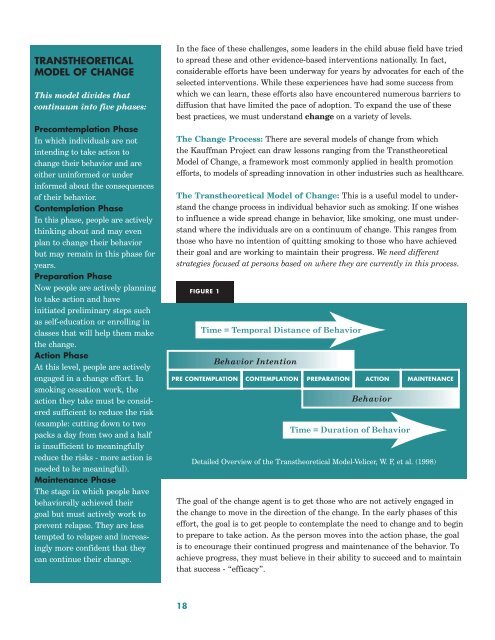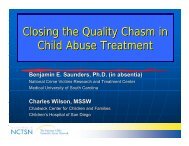Kauffman Best Practices Project Final Report - The Chadwick Center ...
Kauffman Best Practices Project Final Report - The Chadwick Center ...
Kauffman Best Practices Project Final Report - The Chadwick Center ...
You also want an ePaper? Increase the reach of your titles
YUMPU automatically turns print PDFs into web optimized ePapers that Google loves.
TRANSTHEORETICAL<br />
MODEL OF CHANGE<br />
This model divides that<br />
continuum into five phases:<br />
Precomtemplation Phase<br />
In which individuals are not<br />
intending to take action to<br />
change their behavior and are<br />
either uninformed or under<br />
informed about the consequences<br />
of their behavior.<br />
Contemplation Phase<br />
In this phase, people are actively<br />
thinking about and may even<br />
plan to change their behavior<br />
but may remain in this phase for<br />
years.<br />
Preparation Phase<br />
Now people are actively planning<br />
to take action and have<br />
initiated preliminary steps such<br />
as self-education or enrolling in<br />
classes that will help them make<br />
the change.<br />
Action Phase<br />
At this level, people are actively<br />
engaged in a change effort. In<br />
smoking cessation work, the<br />
action they take must be considered<br />
sufficient to reduce the risk<br />
(example: cutting down to two<br />
packs a day from two and a half<br />
is insufficient to meaningfully<br />
reduce the risks - more action is<br />
needed to be meaningful).<br />
Maintenance Phase<br />
<strong>The</strong> stage in which people have<br />
behaviorally achieved their<br />
goal but must actively work to<br />
prevent relapse. <strong>The</strong>y are less<br />
tempted to relapse and increasingly<br />
more confident that they<br />
can continue their change.<br />
In the face of these challenges, some leaders in the child abuse field have tried<br />
to spread these and other evidence-based interventions nationally. In fact,<br />
considerable efforts have been underway for years by advocates for each of the<br />
selected interventions. While these experiences have had some success from<br />
which we can learn, these efforts also have encountered numerous barriers to<br />
diffusion that have limited the pace of adoption. To expand the use of these<br />
best practices, we must understand change on a variety of levels.<br />
<strong>The</strong> Change Process: <strong>The</strong>re are several models of change from which<br />
the <strong>Kauffman</strong> <strong>Project</strong> can draw lessons ranging from the Transtheoretical<br />
Model of Change, a framework most commonly applied in health promotion<br />
efforts, to models of spreading innovation in other industries such as healthcare.<br />
<strong>The</strong> Transtheoretical Model of Change: This is a useful model to understand<br />
the change process in individual behavior such as smoking. If one wishes<br />
to influence a wide spread change in behavior, like smoking, one must understand<br />
where the individuals are on a continuum of change. This ranges from<br />
those who have no intention of quitting smoking to those who have achieved<br />
their goal and are working to maintain their progress. We need different<br />
strategies focused at persons based on where they are currently in this process.<br />
FIGURE 1<br />
Detailed Overview of the Transtheoretical Model-Velicer, W. F, et al. (1998)<br />
<strong>The</strong> goal of the change agent is to get those who are not actively engaged in<br />
the change to move in the direction of the change. In the early phases of this<br />
effort, the goal is to get people to contemplate the need to change and to begin<br />
to prepare to take action. As the person moves into the action phase, the goal<br />
is to encourage their continued progress and maintenance of the behavior. To<br />
achieve progress, they must believe in their ability to succeed and to maintain<br />
that success - “efficacy”.<br />
18






